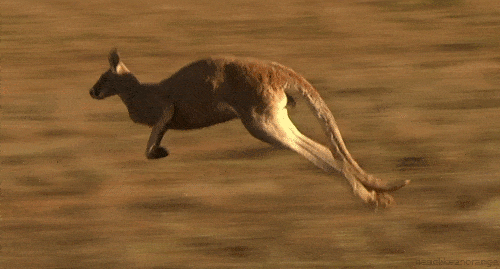Professor Terry Dawson of the University of New South Wales and colleagues found that kangaroos use their tail as an extra leg when walking, actively participating with energy in the process, instead of using it like a strut as some literature would had us believe. The findings might prove to be important for robotics applications.
Hoppity hop
The kangaroo is Australia’s trademark animal and it’s easy to see why: it’s unique to the region, it’s the only large animals that moves by hoping, and it looks downright adorable, though maybe not that much when they’re born – during this time they look like pink, hairless worms. Because they hop, some people might think kangaroos are clumsy, but they couldn’t be farther from the truth. Kangaroos are very agile animals and can run very fast, if they have to, and the prime instrument that aids them in this is their tail.
Previously, professor Dawson showed that when they hop, kangaroos use their tail to counterbalance. Now, he and his team demonstrate that the kangaroo tail is much more important than previously believed, actively participating in walking, like an extra limb. “Hopping is an exaggerated gallop, enabling the kangaroo to make longer steps,” says Dawson.
Researchers noticed that kangaroos use what’s called a “pentapedal tail walk” when moving about. This unusual pose means the animals always has three points on the ground, one of which always being the tail and the other two either the forelimbs or forelimbs. However, this has always struck scientists as very peculiar since the gait of the pentapedal tail walk is less energy efficient than walking on four legs. Evolution closely follows the most energy efficient solution, most of the time.
However, if kangaroos use their tails for walking too, than the pentapedal walk isn’t inefficient at all. To put this idea to the test, Dawson and colleagues trained one male and four female red kangaroos to walk over a force measuring platform which monitored how the different parts that interact mechanically expel energy. The researchers found that kangaroos walk by using the tail to lift both hind legs and the body’s centre of gravity forward, while the forelimbs were used as struts and didn’t provide any of the propulsion.
In fact, results show a kangaroos tail provides at least just as much energy as a hind leg – between a quarter and a third of the full propulsion needed to move the animal forward. As it is, their tails are indispensable and their stride energy efficient.
“The muscle structure of the front legs have little mitochondria and they’re not organised for propulsion, so instead of the tail being the strut, the front legs were filling that role,” says Dawson.
“I can now understand where that energy goes and why if they’re going to walk more than 5 metres they get up and hop instead.”
The insights the team garnered could be used in robotics, where stable mechanical structures are always welcome.
“There’s interest in the robotic side of things and how other forms of locomotion can work,” says Dawson.
“You can locomote just using your legs, but there are other options for stability and it’s interesting from that point of view.”
Results were published in the Royal Society Biology Letters.










